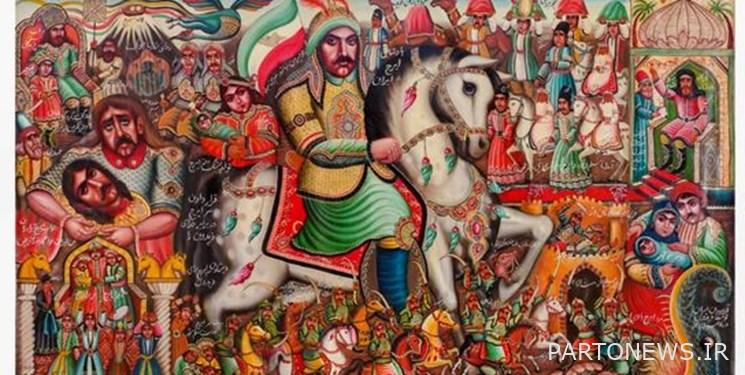The exhibition of the revival of the art of curtain drawing and coffee house painting

According to Fars news agency, the exhibition “Revival of the Art of Curtain Drawing and Coffee House Painting” with the works of Mehdi Talenia was held at Iran Artists’ House.
A work by Mehdi Talenia

A work by Mehdi Talenia

A work by Mehdi Talenia

A work by Mehdi Talenia

A work by Mehdi Talenia

A work by Mehdi Talenia
Coffee house painting is a term for a kind of narrative painting with a religious or martial subject and sometimes a goat, which was painted by the artists of the unseen school with oil paint technique. This art is symmetrical with the constitutional era, based on the traditions of popular and religious art and influenced by the popular naturalist painting at that time. The painters of this discipline chose the title of “Imagination” for their works in order to be different from the painters who focused on objective reality. The painting of coffeehouses, which is a unique phenomenon in the contemporary art of Iran, is important in many ways, both sociologically and culturally and aesthetically.
What is Kuva Khaneh painting?
Coffee house painting is one of the types of painting in Iran, which became popular in Iran during the constitutional period. This type of painting is actually a narrative of Iranian war, war and religion. The painting of a coffee house originated from the Qajar school in Iranian painting, which dates back to before the Qajar era, but it peaked at the end of the Qajar era and the constitutional movement, and it left its most prominent effects in the Pahlavi era. Unlike other Iranian schools of painting and illustration, which all flourished in the academic field, coffeehouse painting grew and developed outside the official field and by people who did not attend school. Researchers consider the history of folk religious painting in Iran to be related to the Safavids, when Shiism spread a lot. For example, in the murals of Shahzaid Imamzadeh in Isfahan, scenes from Imam Hossein’s ta’ziyya (a.s.) are depicted. It is only in the style of drawing and image of the clothes of these works that a faint reflection of the atmosphere of the Safavid courts can be felt. This kind of painting that reflects national hopes and interests, religious beliefs and the spirit of culture specific to the middle layers of urban society. It was a newer phenomenon than other forms of folk painting such as: curtain drawing, Bekaa Motbarake wall painting, painting behind glass with religious themes and others.
The stories of Ferdowsi’s Shahnameh and Khamsa Nizami, the events of Karbala, Quranic stories and folk tales are the main subjects of coffeehouse painting. The painter describes this subject in accordance with the description that you hear from the narrators, reciters, madahs, and prayer reciters, and depicts it as it was in the minds of the people of the streets and markets.
Narrative in coffee house painting
One of the characteristics of coffeehouse paintings is the narration of the created painting curtains. In order for the general public to see the events and keep them in their memory, the artist-painter depicts everything that the narrator and Shahnameh Khan said along with his imagination. Sometimes the painter may depict several different images for a story that show different moments in different times or in parallel times in the same story. In this way, different scenes that are not related to each other in terms of time may be brought together in one tableau. In addition, many panels are also made that express only one scene from the climax of the said story.
In order to express the characteristics of coffee house painting, we must divide these paintings into two categories: the first category has general characteristics that are more accepted than the traditional style paintings of Iran. Innovations have emerged in this style that distinguish it from other painting styles of the Qajar school. These features are specific to the paintings of Ali Reza QollerAghasi and Hossein QollerAghasi and his students, although they are sometimes seen in the paintings of Mohammad Modbar. The second category is paintings that, in addition to observing the general characteristics of traditional paintings, are also influenced by Western painting, examples of which can be seen in the works of Mohammad Modbar and his students.
end of message/
You can edit this article
Suggest this article for the first page

